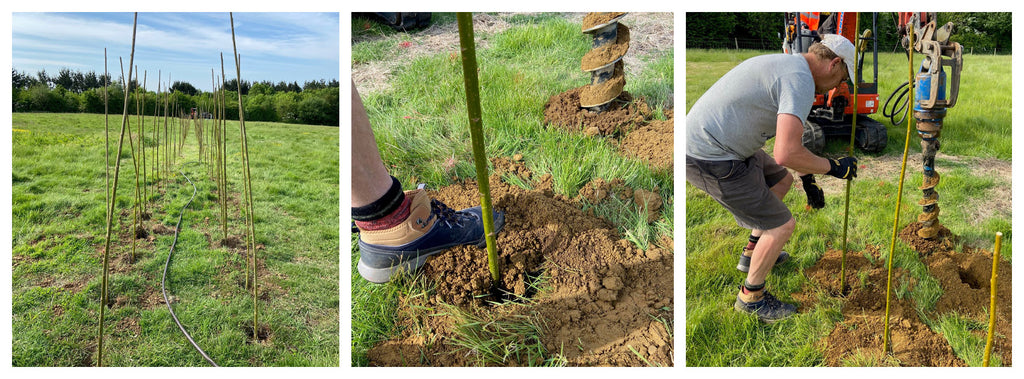
Agroforestry at The Garlic Farm
This year we made a decision to plant 2500 willow whips amounting to 600 metres of willow rows through two fields on the farm. One field is permanent pasture for our herd of cows, the other is part of our 5 year organic garlic rotation. We were expertly guided through this process by Neil Watkins and his team at EcoCrops. We ended up planting a very thirsty species of tree at the beginning of the ‘drought’ in May and without their expert knowledge the whole project would surely have failed.

So why would we take up valuable arable and grazing space with trees that we already have lots of around the farm?
As one might expect there are multiple reasons that a farmer may decide to do such a thing and taken together they appear to offer a host of benefits that outweigh the initial seeming loss of farmable, grazeable land.
Rows of trees through open land provide:
- Shade, shelter and browsing for our grazing animals. This provides better conditions for livestock in extreme weather conditions reducing stress on the animals and also providing a source of highly nutritious food for them in the form of ‘browsing’. Basically nibbling leaves.
- Wildlife corridors and habitat creation. Field mice, hedgehogs, stoats, weasels and lots of other species can move between parcels of land that would otherwise be too dangerous for them to cross. This restriction of certain species to smaller areas than they would naturally need to inhabit is often a cause for their deteriorating numbers. Birds, bees and a host of other insects are attracted to the willow. It has been observed that diversity in natural habitats is the key to their resilience. Creating biodiversity wherever possible on the farm seems to be the obvious path to increased resilience.
- Soil erosion. Trees can help prevent the worst of the kind of soil erosion that occurs when wind and rain washes the top soil away to the nearest watercourse and causes untold problems for the waterways as well as for the farm that is losing its best soil.
- Soil health. All of this can really be linked to soil health. However, there is a growing body of evidence that describes how trees and their root systems directly interact with organisms in the soil creating a symbiotic relationship that provides the environment that plants need to become resilient to disease and increasingly unpredictable weather patterns. This is a complicated subject but for those that would like to delve further you could start here:https://integritysoils.com/
- Woodchip and biomass. We have planted particular varieties of willow that are fast growing and well suited to providing woodchip that we hope to eventually feed into our biomass boiler that heats the farm shop, restaurant and all our self-catering accommodation. We can coppice these willow rows every 3-4 years. Woodchip is also a fantastically useful resource on farm as a mulch for trees and plants and also as a compost when left for 18 months or longer, augmenting soil health and increasing organic matter on the land.

For further reading around the concepts in this article you can check out these fantastic resources:
Click below to read about how The Soil Association are hoping to get half of UK farms to integrate agroforestry systems!
https://www.soilassociation.org/causes-campaigns/agroforestry/
The Woodland Trust have an insightful report on how bringing trees into farms will make them more resilient economically and environmentally.
https://www.woodlandtrust.org.uk/plant-trees/agroforestry-benefits/
It's clear we need more trees, and farms are a good place to put them!














